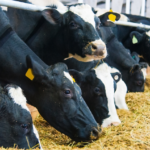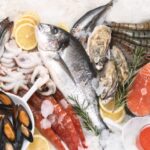
Decoding Food Labels
In the U.S., we are privileged to have so many food choices. When purchasing items at the grocery store, consumers can choose from products labeled as natural, organic and free-range, among others. But what do all of those labels really mean? We searched out definitions for a few labels from the USDA, which regulates meat, poultry and processed egg products.
- Cage free: This label indicates that the flock was able to freely roam a building, room, or enclosed area with unlimited access to food and fresh water during their production cycle.
- Note: There are no regulations for outdoor access with the cage-free label.
- Free range or free roaming: Producers must demonstrate to the USDA that the poultry has been allowed access to the outside.
- Grass-fed (or forage-fed): Grass and forage shall be the feed source consumed for the lifetime of the ruminant animal (like cattle), with the exception of milk consumed prior to weaning. The diet shall be derived solely from forage consisting of grass, forbs (e.g., legumes, Brassica), browse (e.g. twigs, leaves), or cereal grain crops in the vegetative (pre-grain) state. Animals cannot be fed grain or grain byproducts and must have continuous access to pasture during the growing season. Hay, haylage, baleage, silage, crop residue without grain, and other roughage sources may also be included as acceptable feed sources. Routine mineral and vitamin supplementation may also be included in the feeding regimen. If incidental supplementation occurs due to inadvertent exposure to non-forage feedstuffs or to ensure the animal’s wellbeing at all times during adverse environmental or physical conditions, the producer must fully document (e.g., receipts, ingredients, and tear tags) the supplementation that occurs including the amount, the frequency, and the supplements provided.
- Humane: Multiple labeling programs make claims that animals were treated humanely during the production cycle, but the verification of these claims varies widely. These labeling programs are not regulated.
- Natural: As required by USDA, meat, poultry, and egg products labeled as “natural” must be minimally processed and contain no artificial ingredients. However, the natural label does not include any standards regarding farm practices and only applies to processing of meat and egg products. There are no standards or regulations for the labeling of natural food products if they do not contain meat or eggs.
- Note: Food products regulated by the FDA (everything except meat, poultry and processed egg) can also be labeled natural. The FDA notes that from a food science perspective, it is difficult to define a food product that is ‘natural’ because the food has probably been processed and is no longer the product of the earth. The FDA has not developed a definition for use of the term natural or its derivatives. However, the agency has not objected to the use of the term if the food does not contain added color, artificial flavors, or synthetic substances.
- Naturally raised: Livestock used for the production of meat and meat products that have been raised entirely without growth promotants, antibiotics (except for ionophores used as coccidiostats for parasite control), and have never been fed animal (mammalian, avian, or aquatic) by-products derived from the slaughter/harvest processes, including meat and fat, animal waste materials (e.g., manure and litter), and aquatic by-products (e.g., fishmeal and fish oil). All products labeled with a naturally raised marketing claim must incorporate information explicitly stating that animals have been raised in a manner that meets the following conditions: 1) no growth promotants were administered to the animals; 2) no antibiotics (other than ionophores used to prevent parasitism) were administered to the animal; and 3) no animal by-products were fed to the animals. If ionophores used only to prevent parasitism were administered to the animals, they may be labeled with the naturally raised marketing claims if that fact is explicitly noted.
- No hormones (hogs and poultry): Hormones are not ever allowed in raising hogs or poultry. Therefore, the claim “no hormones added” cannot be used on the labels of pork or poultry unless it is followed by a statement that says “Federal regulations prohibit the use of hormones.”
- No hormones (beef): The term “no hormones administered” may be approved for use on the label of beef products if sufficient documentation is provided to the USDA by the producer showing no hormones have been used in raising the animals.
- No antibiotics (red meat and poultry): The terms “no antibiotics added” may be used on labels for meat or poultry products if sufficient documentation is provided by the producer to the USDA demonstrating that the animals were raised without antibiotics.
- Organic: Food or other agricultural products that have been produced without synthetic fertilizers, sewage sludge, irradiation, and genetic engineering. Organic production integrates cultural, biological, and mechanical practices that foster cycling of resources, promote ecological balance, and conserve biodiversity.
- Note: Pesticides derived from natural sources (such as biological pesticides) may be used in producing organically-grown food.
- The National Organic Program regulates all organic crops, livestock, and agricultural products certified to the USDA organic standards. Organic certification agencies inspect and verify that organic farmers, ranchers, distributors, processors, and traders are complying with the USDA organic regulations. USDA conducts audits and ensures that the more than 90 organic certification agencies operating around the world are properly certifying organic products. In addition, USDA conducts investigations and conducts enforcement activities to ensure all products labeled as organic meet the USDA organic regulations. In order to sell, label, or represent their products as organic, operations must follow all of the specifications set out by the USDA organic regulations.
- To know if your food is organic, look at the label. If you see the USDA organic seal, the product is certified organic and has 95 percent or more organic content. For multi-ingredient products such as bread or soup, if the label claims that it is made with specified organic ingredients, you can be confident that those specific ingredients have been certified organic.
- Pasture-raised: Due to the number of variables involved in pasture-raised agricultural systems, the USDA has not developed a labeling policy for pasture-raised products.
Click here to read more information about the Nutrition Facts label.
Image: “NOV 20 – SNAP – Grocery Shopping” by U.S. Department of Agriculture is licensed under CC BY 2.0.

























